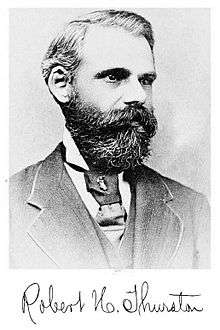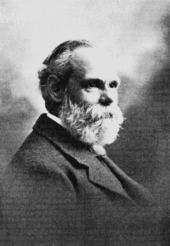Robert Henry Thurston
| Robert Henry Thurston | |
|---|---|
 | |
| Born |
October 25, 1839 Providence, Rhode Island |
| Died |
October 25, 1903 (aged 64) Ithaca, New York |
Robert Henry Thurston (October 25, 1839 – October 25, 1903) was an American engineer, and the first Professor of Mechanical Engineering at Stevens Institute of Technology.
He was Assistant Professor at the US Naval Academy in Annapolis and a published specialist on iron and steel as well as steam engines, when he was invited in 1871 by Stevens' president Henry Morton to head mechanical engineering at Stevens. The same year Thurston was appointed the first professor of mechanical engineering at Stevens Institute of Technology.
Biography
Thurston was born 1839 in Providence, Rhode Island, the eldest son of Robert Lawton and Harriet Thurston of Providence. He was trained in the workshop of his father, and graduated from Brown University in 1859.[1]
Thurston was engaged with the business firm of which his father was senior partner until 1861, when he entered the navy as an officer of engineers. He served during the civil war on various vessels, and was present at the Battle of Port Royal and at the Siege of Charleston. He was attached to the North and South Atlantic squadrons until the close of 1865.[1]
In 1865 he was stationed as Assistant Professor of Natural and Experimental Philosophy at the United States Naval Academy at Annapolis, where he also acted as lecturer on chemistry and physics. In 1870 he visited Europe, for the purpose of studying the British iron manufacturing districts, and in 1871 was appointed Professor of Mechanical Engineering at the Stevens Institute of Technology. In that year he conducted, in behalf of a committee of the American Institute, a series of experiments on steam boilers, in which, for the first time, all losses of heat were noted, and by condensing all the steam generated, the quantity of water entrained by the steam was accurately noted.[1]

In 1873 he was appointed a member of the United States Scientific Commission to the Vienna Exhibition; served upon the international jury, edited the Report of the Commissioners (in which he published his own report on machinery and manufactures), in five volumes, 1875–6. In 1874 and subsequently he conducted, at the Stevens Institute of Technology, a series of researches on the efficiency of prime movers and machines, and upon the strength and other essential properties of the materials of construction. In 1875 he was appointed a member of the United States Commission on the causes of boiler explosions, and of the Board to test the metals used in construction. He is a member of various scientific associations in the United States, Great Britain, France, and Germany, and has written numerous papers on technical subjects, which have appeared in scientific journals in Europe and America, and has prepared articles upon similar topics for this Cyclopedia.[1]
He was made vice-president of the American Institute of Mining Engineers in 1875; he was made vice-president of the American Association for the Advancement of Science, at Nashville, in 1877, in the absence of Professor Pickering, elected at the preceding meeting, and was regularly elected to serve again in 1878, at the St. Louis meeting of the association.[1] From 1880 to 1882 Thurston was the first president of the American Society of Mechanical Engineers. In 1885 he left the Stevens Institute of Technology to replace John Edison Sweet as director of Sibley College at Cornell University, reorganizing it as a college of mechanical engineering.
In 1885, he received an honorary Degree of Engineering from Stevens. He died 1903 in Ithaca, New York.
Work
Thurston's research interest was in the areas of materials, thermodynamics, steam engines and boilers, friction and energetics.
Mechanical engineering curriculum
At the Stevens Institute of Technology he established Stevens' mechanical engineering curriculum. He was committed to the French and German science-based models of technical education and soon would gain an international reputation for his view of engineering as applied science. His enthusiasm in involving students in funded research led to remarkable pioneering success of the early Stevens' graduates.
Historians credit Thurston with establishing the first US mechanical engineering laboratory for conducting funded research at an academic institution for higher learning.
The Mechanical Engineer, his Preparation and his Work
The 1874 paper "The Mechanical Engineer, his Preparation and his Work" according to Popular Science Monthly (1875 8:376) is:
- ...an address to a graduating class of the Stevens Institute of Technology, by the Professor of Mechanical Engineering. Prof. Thurston, in the first place, recalls to the minds of the young engineers the rare educational advantages they have enjoyed at the Institute: very full instruction in mathematics and physics; in modern languages; the English language and literature; principles of engineering, and the practice of the arts connected therewith. So far, the students have been working at the foundation; the superstructure they must build by their own efforts. The professor exhorts them to be wide-awake, observant, conscientious, true to their clients, progressive, radical in theory but conservative in practice, and diligent in study.[2]
Other papers
Thurston wrote a number of papers embodying accounts of original investigations of the strength and other properties of construction materials. Among his numerous inventions are the magnesium ribbon lamp, a magnesium-burning naval and army signal apparatus, an autographic recording testing machine, a new form of steam engine governor, and an apparatus for determining the value of lubricants.[1] In 1875, he also developed the three-coordinate solid diagram for testing iron, steel, and other metals.
Patents
Thurston held two patents: one for an autographic recording testing machine for material in torsion and the other for a machine for testing lubricants.
Publications
Books, a selection:
- 1878. A history of the growth of the steam engine. D. Appleton and Company; 4th, revised ed. 1902 (online)
- 1884. Stationary steam engines; especially as adapted to electric lighting purposes. New York, J. Wiley & sons, 1884.
- 1884. Materials of Engineering. J. Wiley, 1884, Parts, 1, 2 & 3
- 1889. The development of the philosophy of the steam-engine. An historical sketch. New York, J. Wiley & sons.
- 1890. Heat as a form of energy. Boston and New York, Houghton, Mifflin and company, 1890.
- 1891. A manual of the steam-engine. For engineers and technical schools; advanced courses. New York, J. Wiley & sons, 1891.
- 1894. The animal as a machine and a prime motor, and the laws of energetics. New York, J. Wiley & sons.
Some of his more important papers are the following:[1]
- 1865. On Losses of Propelling Power in the Paddle Wheel
- 1865. Steam Engines of the French Navy
- 1870. H. B. M. Iron Clad Monarch
- 1870. Iron Manufactures in Great Britain
- 1871. Experimental Steam Boiler Explosions
- 1871. Report on Test Trials of Steam Boilers
- 1872. Traction Engines and Road Locomotives
- 1874. Efficiency of Furnaces Burning Wet Fuel
- 1874. The Mechanical Engineer, his Preparation and his Work
- 1877, On a New Method of Planning Researches and of Representing to the Eye the Results of Combination of three or more Elements in Varying Proportions
Publications about Thurston
- ASME History and Heritage Committee (1980); Mechanical Engineers in America Born Prior to 1861: A Biographical Dictionary. New York: ASME. Library of Congress No. 79-57364.
- Calvert, Monte A. Mechanical Engineer in America, 1830-1910: Professional Cultures in Conflict. Baltimore: The Johns Hopkins University Press, 1967.
- Clark, Geoffrey W. (2000); History of Stevens Institute of Technology: A Record of Broad-Based Curricula and Technogenesis. Jersey City, New Jersey: Jensen/Daniels.
- Sinclair, Bruce (1980); A Centennial History of the American Society of Mechanical Engineers, 1880-1980. (Toronto: Published for ASME by University of Toronto Press, 1980). ISBN 0-8020-2380-0.
- Durand, William F. (1929): "Robert Henry Thurston" The Riverside Press Cambridge, Massachusetts 1929 Copyright by the American Society of Mechanical Engineers A.S.M.E. First Edition.
References
- 1 2 3 4 5 6 7 Johnson's Universal Cyclopedia, 1878; cited in: Brown Thurston (1880) Thurston genealogies. Published 1880 by B. Thurston. p, 337-338
- ↑ Popular Science Monthly. (1875) Volume 8. p.376 (wikisource)
External links
-
 Media related to Robert Henry Thurston at Wikimedia Commons
Media related to Robert Henry Thurston at Wikimedia Commons -
 Works written by or about Robert Henry Thurston at Wikisource
Works written by or about Robert Henry Thurston at Wikisource -
 Quotations related to Robert Henry Thurston at Wikiquote
Quotations related to Robert Henry Thurston at Wikiquote - Works by Robert Henry Thurston at Project Gutenberg
- Works by or about Robert Henry Thurston at Internet Archive